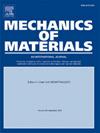Enhancing robustness in machine-learning-accelerated molecular dynamics: A multi-model nonparametric probabilistic approach
IF 3.4
3区 材料科学
Q2 MATERIALS SCIENCE, MULTIDISCIPLINARY
引用次数: 0
Abstract
In this work, we present a system-agnostic probabilistic framework to quantify model-form uncertainties in molecular dynamics (MD) simulations based on machine-learned (ML) interatomic potentials. Such uncertainties arise from the design and selection of ML potentials, as well as from training aspects pertaining to the definition of datasets and calibration strategies. Our approach relies on a stochastic reduced-order model (SROM) where the approximation space is expanded through the randomization of the projection basis. The construction of the underlying probability measure is achieved in the context of information theory, by leveraging the existence of multiple model candidates, corresponding to different ML potentials for instance. To assess the effectiveness of the proposed approach, the method is applied to capture model-form uncertainties in a sodium thiophosphate system, relevant to sodium-ion-state batteries. We demonstrate that the SROM accurately encodes model uncertainties from different ML potentials – including a Neuro-Evolution Potential (NEP) and a Moment Tensor Potential (MTP) – and can be used to propagate these uncertainties to macroscopic quantities of interest, such as ionic diffusivity. Additionally, we investigate the impact of augmenting the snapshot matrix with momenta, and of introducing a frequency-based split in the construction of the random projection matrix. Results indicate that including momenta improves the accuracy of the SROM, while frequency splitting enables stabilization around nominal responses during uncertainty propagation. The proposed enhancements contribute to more robust and stable predictions in MD simulations involving ML potentials.
增强机器学习加速分子动力学的鲁棒性:一种多模型非参数概率方法
在这项工作中,我们提出了一个系统不可知的概率框架来量化基于机器学习(ML)原子间势的分子动力学(MD)模拟中模型形式的不确定性。这种不确定性来自机器学习电位的设计和选择,以及与数据集定义和校准策略相关的训练方面。我们的方法依赖于随机降阶模型(rom),其中通过投影基的随机化扩展了近似空间。底层概率度量的构建是在信息论的背景下实现的,通过利用多个候选模型的存在,例如对应于不同的ML潜力。为了评估所提出方法的有效性,将该方法应用于捕获与钠离子状态电池相关的硫代磷酸钠系统中的模型形式不确定性。我们证明,rom准确地编码来自不同ML势的模型不确定性-包括神经进化势(NEP)和矩张量势(MTP) -并可用于将这些不确定性传播到感兴趣的宏观量,如离子扩散率。此外,我们还研究了用动量增加快照矩阵的影响,以及在随机投影矩阵的构造中引入基于频率的分裂。结果表明,加入动量可以提高rom的精度,而分频可以在不确定性传播过程中稳定在标称响应附近。提出的增强有助于在涉及ML电位的MD模拟中进行更稳健和稳定的预测。
本文章由计算机程序翻译,如有差异,请以英文原文为准。
求助全文
约1分钟内获得全文
求助全文
来源期刊

Mechanics of Materials
工程技术-材料科学:综合
CiteScore
7.60
自引率
5.10%
发文量
243
审稿时长
46 days
期刊介绍:
Mechanics of Materials is a forum for original scientific research on the flow, fracture, and general constitutive behavior of geophysical, geotechnical and technological materials, with balanced coverage of advanced technological and natural materials, with balanced coverage of theoretical, experimental, and field investigations. Of special concern are macroscopic predictions based on microscopic models, identification of microscopic structures from limited overall macroscopic data, experimental and field results that lead to fundamental understanding of the behavior of materials, and coordinated experimental and analytical investigations that culminate in theories with predictive quality.
 求助内容:
求助内容: 应助结果提醒方式:
应助结果提醒方式:


